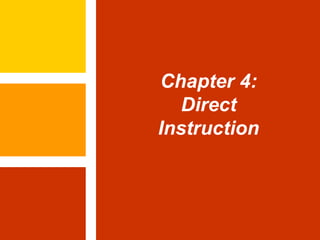
Ch 4 PowerPoint
- 1. Chapter 4: Direct Instruction
- 14. The Stages of Direct Instruction (Summary) Stage Teacher Action Student Response Notes Focus Activity Quick 2-3 minute activity that engages students’ interest and promotes students’ thinking Answers questions and participates in the activity May involve review of yesterday’s lesson or related skill Stating the Objective Describes in students’ terms what they will be doing today Listen Adjust vocabulary to suit particular group of students Providing the Rationale Describes why the content from today’s lesson is important and meaningful to students Listen Find current relevance—not “You’ll need this next year.”
- 15. The Stages of Direct Instruction (Summary continued) Stage Teacher Action Student Response Notes Content Presentation Presents the content of the lesson sequentially Listen and observes instruction Prepare for clarity of instruction, systematically given Modeling Demonstrates skills, procedures, does “think alouds Observe Consider using visual, auditory, kinesthetic, and tactile Modeling
- 16. The Stages of Direct Instruction (Summary continued) Stage Teacher Action Student Response Notes Checking for Understanding Asks specific questions to assess student understanding of the content, procedure, or skill taught Answers questions individually, chorally, verbally, and with signaling Intersperse Checking for Understanding questions throughout Content Presentation and Modeling sequence as needed
- 17. The Stages of Direct Instruction (Summary continued) Stage Teacher Action Student Response Notes Guided Practice Provides short practice period under the guidance of the teacher. Dismiss individual students as they are ready for Independent Practice Performs task or work with content individually while being monitored Check individual students’ work frequently to troubleshoot errors
- 18. The Stages of Direct Instruction (Summary continued) Stage Teacher Action Student Response Notes Closure “ Ties the bow” on the lesson Reviews the importance of the content May also preview what will happen tomorrow Students summarize or comment on the content of the lesson Providing Closure is most effective when students participate Mass Practice Provides frequent opportunities to practice skill Practices skill or works with content Mass practice periods should immediately follow initial mastery of objective for the next few days to ensure “overlearning”
- 19. The Stages of Direct Instruction (Summary continued) Stage Teacher Action Student Response Notes Distributive Practice Provides brief, intermittent practice over the rest of the school year to keep skills fresh Practices skill or works with content Brief homework practice may serve this purpose
- 21. Direct Instruction and Learning Theory Behaviorism and Direct Instruction Behaviorism Direct Instruction Information should be presented in small amounts Task analysis Content presentation Many opportunities for immediate positive feedback Checking for understanding Use of question-answer format Checking for understanding Student responses required Checking for understanding Questions arranged in level of difficulty Task analysis Content presentation
- 22. Direct Instruction and Learning Theory Cagne’s Phases of Learning/Information Processing/Direct Instruction Cagne’s Phases of Learning Information Processing Direct Instruction Gain student attention Reception Gain student attention State the objective Motivation State the Objective Provide the Rationale Recall prior knowledge Retrieval Focus Activity Present stimulus Reception Content Presentation Provide learning guidance Explanations Modeling Provide feedback Reinforcement Checking for Understanding Elicit performance Retrieval Guided Practice Assess performance Retrieval Independent Practice Cue retrieval Retrieval Mass and Distributive Practice